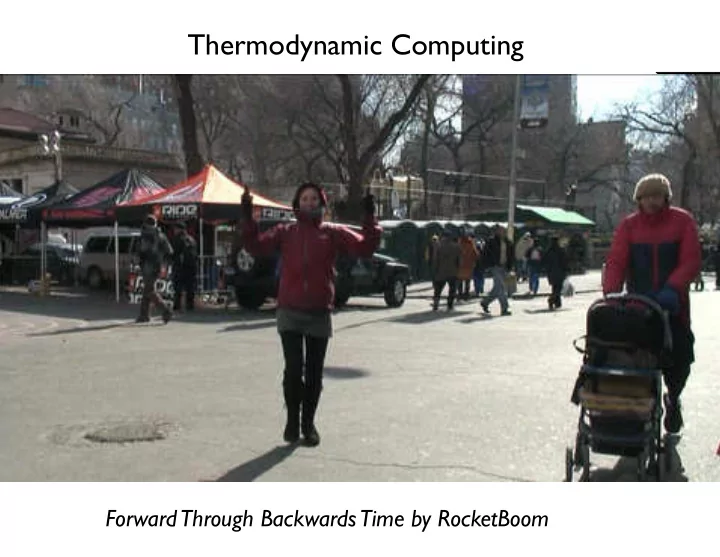

Thermodynamic Computing 1 14 Forward Through Backwards Time by RocketBoom
The 2nd Law of Thermodynamics Total Entropy Clausius inequality ∆ S total ≥ 0 increases (1865) as time progresses R.Penrose (2010) Cycles of time Once or twice I have been provoked and asked the company how many of them could describe the Second Law of Thermodynamics. The response was cold. It was also negative. Yet I was asking something which is about the scientific equivalent of “Have you read a work of Shakespeare's?” -- C. P. Snow Gavin E. Crooks
Thermodynamic Equilibrium: Future, past and present are indistinguishable No change in entropy Gavin E. Crooks
What is Entropy? 1 natural unit of entropy equivalent to 1 kT of thermal energy T : Temperature (ambient 300 Kelvin) k : Boltzmann’s constant 1 kT = 25 meV = 2.5 kJ/mol average kinetic energy = 1.5 kT Gavin E. Crooks
Unfolding of RNA hairpins. (circa 2000) Trap Bead Trap Bead Entropy sometimes Laser goes down! Trap RNA Hairpin probability Actuator unfolding Bead Actuator Bead Pizeoelectic Actuator g n i d l o 0 f n force ∆ S total = 1 u � � g W − ∆ F n i d T l o work total free f entropy temperature energy change change length Gavin E. Crooks
The (improved) 2nd Law of Thermodynamics Clausius inequality Jarzynski identity (1865) (1997) h e − ∆ S total i = 1 h ∆ S total i � 0 equality only for equality far-from-equilibrium reversible process ∆ S total = 1 � � W − ∆ F T Gavin E. Crooks
Fluctuation Theorems: Free Energy Dissipation breaks time-reversal symmetry Work Change Inverse Temperature Forward Trajectory Phase Space Reverse Trajectory Time Gavin E. Crooks
What have we learned? h e − ∆ S total i = 1 • There are exact, general relations valid far-from-equilibrium • Trajectories are the primary objects (rather than states ) • The fluctuations matter • Entropy change breaks time quantitatively reversal symmetry • Directly relevant at small dissipation • Information and entropy are related: Information flow is as important as work and heat flow. Gavin E. Crooks
Experimental verification of Landauer’s principle (2012) linking information and thermodynamics ´rut 1 , Artak Arakelyan 1 , Artyom Petrosyan 1 , Sergio Ciliberto 1 , Raoul Dillenschneider 2 & Eric Lutz 3 { Antoine Be a b 10 10 Erasing 1 bit of information 5 requires at least ln 2 kT 5 energy 0 0 − 0.5 0 0.5 − 0.5 0 0.5 c d 10 10 Potential ( kT ) Thermodynamic entropy 5 5 and Shannon information 0 0 are related − 0.5 0 0.5 − 0.5 0 0.5 e f 10 10 Bits are physical 5 5 0 0 − 0.5 0 0.5 − 0.5 0 0.5 Position ( μ m) Position ( μ m) Non-equilibrium Theory of erasure see: Esposito (2011) Gavin E. Crooks
Experimental verification of Landauer’s principle linking information and thermodynamics ´rut 1 , Artak Arakelyan 1 , Artyom Petrosyan 1 , Sergio Ciliberto 1 , Raoul Dillenschneider 2 & Eric Lutz 3 { Antoine Be c 4 3 Average heat 〈 Q 〉 ( kT ) 2 1 0 0 10 20 30 40 τ (s) Erasure time But: Thermodynamically reversible computation requires Carnot limit, i.e. infinity long time Gavin E. Crooks
Experimental verification of Landauer’s principle linking information and thermodynamics ´rut 1 , Artak Arakelyan 1 , Artyom Petrosyan 1 , Sergio Ciliberto 1 , Raoul Dillenschneider 2 & Eric Lutz 3 { Antoine Be F max (10 − 14 N) b 0.15 P(Heat) 0.10 P(Q) 0.05 − 2 0 2 4 Q ( kT ) Heat Fluctuations matter! Tradeoff between error, time, and energy Gavin E. Crooks
Research Highlights Feedback Fluctuation Theorems (c2010) D T ( W − ∆ F ) − I E e − 1 = 1 Demon-system information Sagawa & Ueda (2008) Horowitz & Vaikuntanathan (2010) Gavin E. Crooks
Research Highlights Thermodynamics of Prediction Still, Sivak, Bell, Crooks (2012) Gavin E. Crooks
Research Highlights 1/2 Coupled Systems Optimal Experiments thermodynamic control Feynman's ratchet Bang et al (2018) 14 / 22 Gavin E. Crooks
Research Highlights 2/2 time-dissipation-error Thermodynamics tradeoff uncertainty realtions Lahiri, Sohl-Dickstein, T. R. Gingrich, J. M. Horowitz, N. Perunov Ganguli (2016) and J. L. England (2015) Self-organization and the generation of complexity Gavin E. Crooks
16 / 22 Gavin E. Crooks
Recommend
More recommend